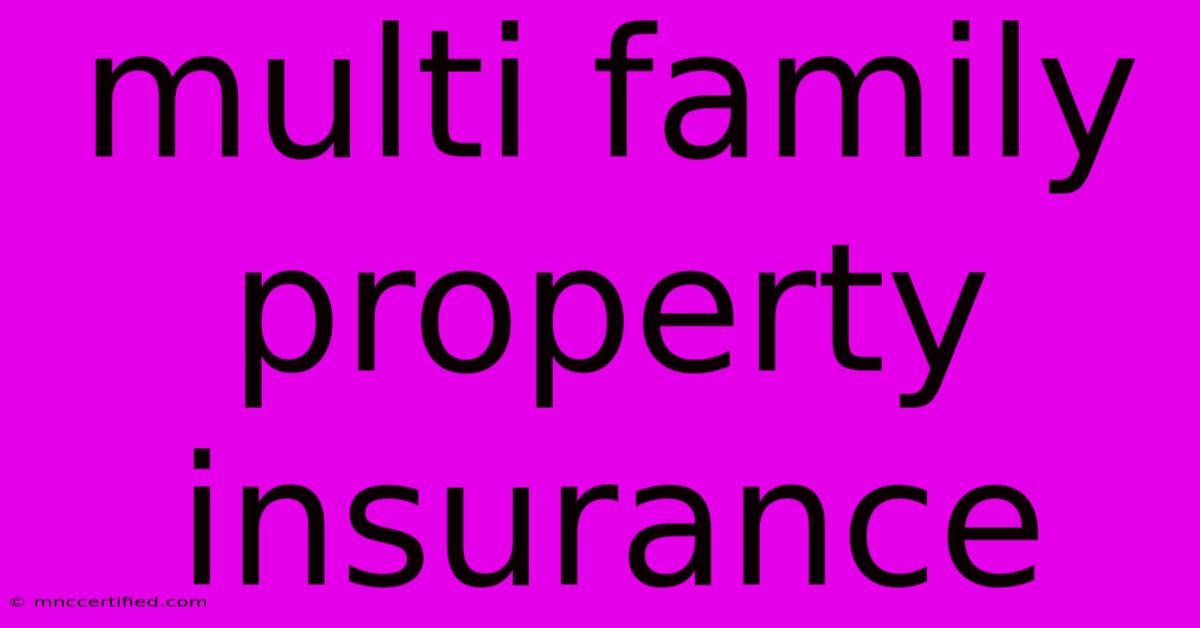Multi Family Property Insurance

Table of Contents
Multi-Family Property Insurance: A Comprehensive Guide for Owners and Investors
Finding the right multi-family property insurance can feel overwhelming. This comprehensive guide will walk you through everything you need to know, from understanding your coverage options to securing the best rates. Whether you own a small apartment building or a large complex, protecting your investment is paramount.
What is Multi-Family Property Insurance?
Multi-family property insurance, also known as apartment building insurance, protects your investment property against various risks. Unlike single-family home insurance, it covers multiple residential units under one policy. This coverage typically includes protection against:
- Building damage: Fire, windstorms, hail, vandalism, and other perils can cause significant structural damage. Your policy should clearly define what is covered and any exclusions.
- Liability: This covers legal costs and settlements if someone is injured on your property. This is crucial, especially with multiple tenants.
- Loss of rental income: If a covered event makes your units uninhabitable, this coverage compensates you for lost rental income.
- Additional living expenses: Should a covered event force tenants to relocate, this coverage helps with temporary housing costs.
Key Differences from Single-Family Home Insurance
While there are similarities, multi-family property insurance differs significantly from single-family policies. Key differences include:
- Higher coverage limits: You'll need higher coverage amounts to reflect the increased value of the building and potential liability.
- Specific endorsements: You may require endorsements for specific risks related to multi-family properties, like liability for tenant-caused damage.
- More complex claims process: Claims involving multiple units and tenants can be more intricate.
Choosing the Right Multi-Family Property Insurance Policy
Selecting the right policy involves careful consideration of several factors:
- Building type and age: Older buildings may require more extensive coverage due to increased risk of damage.
- Location: Properties in high-risk areas (flood zones, hurricane zones) will command higher premiums.
- Number of units: The more units you own, the higher the coverage amount you'll need.
- Rental income: Accurate valuation of your rental income is crucial for loss of rental income coverage.
- Insurance company reputation: Research different insurers, comparing their financial strength and customer service ratings.
Essential Coverage Considerations
Don't overlook these crucial coverage areas:
- Liability coverage: Ensure sufficient liability coverage to protect against lawsuits stemming from accidents on your property.
- Loss of rental income: This is critical for financial stability if a covered event displaces your tenants.
- Replacement cost coverage: This ensures you can rebuild or repair your property to its pre-loss condition, regardless of its actual cash value.
How to Find the Best Rates on Multi-Family Property Insurance
Obtaining competitive rates requires proactive research and comparison shopping. Here are some tips:
- Shop around: Get quotes from multiple insurers to compare prices and coverage options.
- Bundle policies: Combining your multi-family property insurance with other policies (e.g., commercial auto insurance) can often lead to discounts.
- Improve your property's safety: Implementing safety measures (e.g., fire alarms, security systems) can reduce premiums.
- Maintain good credit: Your credit score can significantly impact your insurance rates.
- Consider your deductible: A higher deductible generally means lower premiums, but it also means you'll pay more out-of-pocket in case of a claim.
Understanding Your Policy and Filing a Claim
Once you have a policy, thoroughly review it to understand your coverage and exclusions. If you need to file a claim, act promptly and follow the insurer's instructions carefully. Keep detailed records of all communication and documentation related to the claim.
Key Terms to Understand
- Actual Cash Value (ACV): The current market value of your property, minus depreciation.
- Replacement Cost Value (RCV): The cost to replace your property with new materials and labor.
- Deductible: The amount you pay out-of-pocket before your insurance coverage kicks in.
- Premium: The amount you pay regularly for your insurance coverage.
Conclusion: Protecting Your Multi-Family Investment
Multi-family property insurance is a vital investment for any property owner or investor. By understanding your coverage needs, comparing policies, and proactively managing risk, you can protect your assets and ensure your financial security. Remember, regular review of your policy is essential to ensure it remains adequate for your evolving needs. Don't hesitate to consult with an insurance professional for personalized guidance.

Thank you for visiting our website wich cover about Multi Family Property Insurance. We hope the information provided has been useful to you. Feel free to contact us if you have any questions or need further assistance. See you next time and dont miss to bookmark.
Featured Posts
-
Menendez Brothers Reunite In Court
Nov 26, 2024
-
1971 D B Cooper Case Parachute Found
Nov 26, 2024
-
New Clues In The Db Cooper Case
Nov 26, 2024
-
Champions League Matchday 5 Lineup Predictions
Nov 26, 2024
-
Larry Case And The Doe Reference
Nov 26, 2024